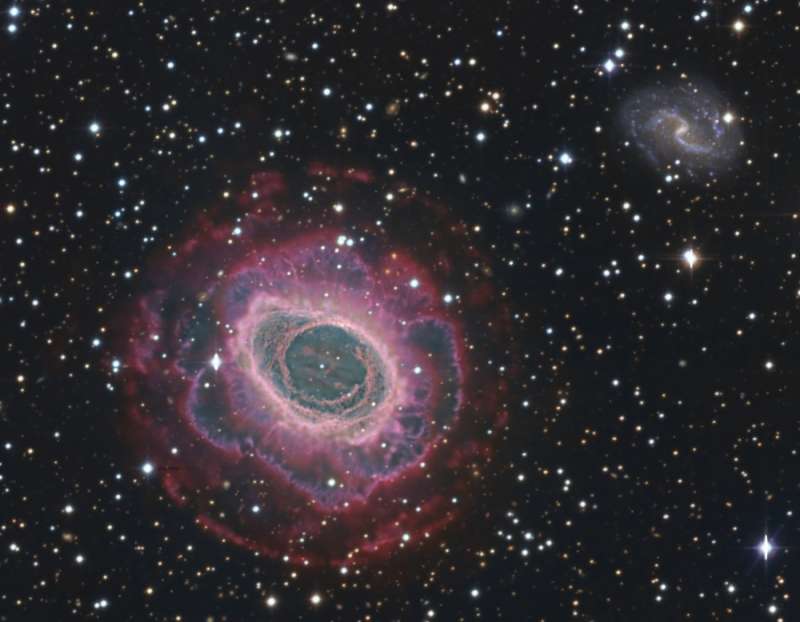Credit & Copyright: Vicent Peris
(DSA /
OAUV /
PixInsight),
Jack Harvey
(DSA /
SSRO),
Steve Mazlin (DSA / SSRO), Jose Luis Lamadrid (DSA / ceFca), Ana Guijarro (CAHA), RECTA, DSA.
Explanation:
A familiar sight to sky enthusiasts with even a small telescope,
the Ring
Nebula (M57) is
some 2,000 light-years away in the musical
constellation
Lyra.
The central ring is about one light-year across,
but this remarkably deep exposure -
a collaborative effort combining data from three different telescopes -
explores
the looping filaments
of glowing gas extending much farther from the nebula's
central star.
Of course, in this
well-studied
example of a
planetary nebula,
the glowing material does not come from planets.
Instead,
the gaseous shroud represents outer layers
expelled from a dying, sun-like star.
This remarkable composite image includes narrowband image data
recording the Ring's atomic hydrogen emission (shown as violet)
in visible light and molecular hydrogen emission (shown as red)
at near infrared wavelengths.
The much more distant spiral
galaxy IC 1296 is also visible at the upper right.
Steve Mazlin (DSA / SSRO), Jose Luis Lamadrid (DSA / ceFca), Ana Guijarro (CAHA), RECTA, DSA.
1999 2000 2001 2002 2003 2004 2005 2006 2007 2008 2009 2010 2011 2012 2013 2014 2015 2016 2017 2018 2019 2020 2021 2022 2023 2024 2025 |
Yanvar' Fevral' Mart Aprel' Mai Iyun' Iyul' Avgust Sentyabr' Oktyabr' Noyabr' Dekabr' |
NASA Web Site Statements, Warnings, and Disclaimers
NASA Official: Jay Norris. Specific rights apply.
A service of: LHEA at NASA / GSFC
& Michigan Tech. U.
|
Publikacii s klyuchevymi slovami:
Ring Nebula - deep field - tumannost' - Planetarnaya tumannost'
Publikacii so slovami: Ring Nebula - deep field - tumannost' - Planetarnaya tumannost' | |
Sm. takzhe:
Vse publikacii na tu zhe temu >> | |
